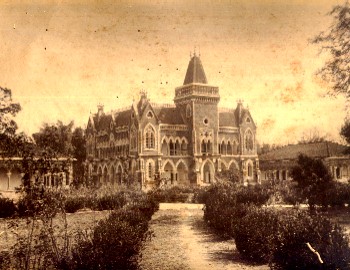 |
|
Victoria Hospital |

Kamania
:
The
Omti nala formed a sort of unofficial
dividing line between the Civil Station & Cantonment on one side and main
town & basti on the other. In
stark contrast to the chic and fashion of Sadar
Bazar, was the densely populated hubbub of the town market. To the western
eyes, the shops were quaint and full of mystery and into the narrow lanes the
memsahibs, if ever, ventured.
The
area in the recent times has developed beyond recognition. And yet the relative
contrast between the old town and sadar area areas continues. Kamania,
the gateway to this hubbub area, itself is a relic, dating back to the
pre-British period, when it was a Maratha suba, under the Bhonsles of Nagpur,
who had received it as a gift from the Peshwas of Pune in 1798.
In
the lower portion of the archway (the word Kamania
comes from kaman, which means like a ‘bow’ or ‘arch’), can still be
seen. The old Maratha bastions built it in the year 1779 for the protection of
the Nagpur and Sagar roads. At the end of 1817, after the battle of Sitabaldi at
Nagpur, a British force, after some fighting in the surrounding district, took
possession of the fortifcation, thus laying the foundation of their rule in the
city.
The
clock which adorns the gate was added in 1939 to commemorate the historic
Tripuri Congress Session held near what is now called Tilwaraghat garden, which
bear witness to the tussle between Subhash Chandra Bose and Mahatma Gandhi.
Commissioner’s
Residency:
Built
in the year 1821, the Commissioner’s Residency is one of the oldest official
residential mansions in India, still in use. The building was first of its kind
to be put up by the British soon after conquering the city from the Marathas. It
served as residence to the famous William Sleeman, who single handily wiped out
the thugees & pindaris from
central India in the 1830’s and 1840’s. A plaque in his honour installed in
the Christ Church Cathedral by his nephew J. Sleeman in remembrance of his
public duties. In the area which was cleansed by William Sleeman of the thugs, a
town has been named after him called “Sleemenabad”.
The residency was also the focal point
during the Revolt of 1857. W.C.Ershine was then the Commissioner, who was said
to have ‘a limited mind of forms and tables’ and refused to heed warnings of
trouble till the sepoys actually began attacking their European officers in the
barracks. The residency was then hastily fortified with sandbags and two old
pounder canons. All the European families from the Cantonment and the Civil
Station gathered in the house to which the rebels laid siege.
The
mansion has an underground passage which exists even today, it leads out from
the parquet flooring of the ball room. But it obviously does not lead too far,
as Europeans remained holed up in the Residency till the Mutiny, as they called
the first fight for independence in India, was finally crushed.
The
garden, which includes the present day campus of Veterinary College, was part of
its extension. In fact, between 1948 and 1956, when the Commissionery was
abolished, the Residency served as the Veterinary College. But it was restored
as the Commissioner’s residence on the formation of the new Madhya Pradesh.
Hanumantal
:
The
Jabalpur city is built on a chain of reclaimed lakes, ponds, marshy groves and
black rock hills. Each lake or pond has its own significance. To begin with,
Adhar Tal, is named after Gond Prime Minister Adhar Singh and is now site of the
Agriculture University. The Marha Tal, has become the present day commercial hub
of the city while Bhawar Tal now has the city park. Rani Tal, named after Rani
Durgawati, is where the new Sports Complex is being built. And so the city’s
heritage of dozens of ponds and lakes is slowly being gobbled up by
commercialization.
But
undoubtedly, the most historic, important and still in more or less its
original form of all these is, the Hanuman Tal. It also has the most water,
unlike others, it possesses very much the appearance of a lake. It’s around
Hanuman Tal that the old elite of Jabalpur live, a world apart in style and
atmosphere from the Civil station across Omti.
Here
the streets are narrow and lanes narrower still, there housed the kothis of the
rich and the powerful, interspersed with famous temples, large and small. Close
by is the multi-storied place of Raja Gokuldas, with its breathtaking intricate
stone work. It was year 1868-69, Hanumatal was in a very bad shape, its dam had
become very weak and the water of the tank would flow out in the rainy season. A
donation was made by Raja Gokuldas at that time for the repair of the dam of the
tal.
Victoria
Hospital:
 |
|
Victoria Hospital |
The
hospital now known as Seth Govinddas Hospital, in memory of Raja Sahib's
grandson, was built in 1876 as the main city dispensary. When built it was one
of the most beautiful hospital buildings in the country and it had comfortable
accommodation, and all facilities for treatment of both, European and Indian
patients.
At
that time, Jabalpur was prey to multitude of illnesses. The prevailing diseases
of the city were fevers, dysentry and cholera, small pox were occasional
visitants and influenza at times assumed the character of an epidemic. The death
rate then averaged 38 per 1000. Today it is 4 per 1000.